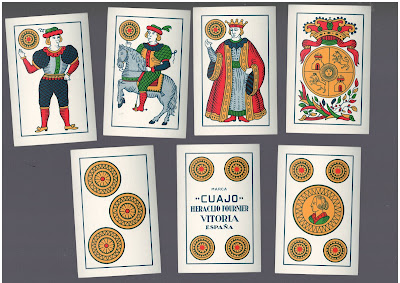For part 1, see here
Walter William Skeat's monumental Malay Magic: An introduction to the popular religion and folklore of the Malay Peninsula is a survey of the customs and folklore of the Malay Peninsula. To give an idea of the expanse of the work, here are some chapter headings "Crocodile folklore" "Funeral prayers" "Birth ceremonies". It was published in 1900.
The book contains two separate accounts of this game. The first and longer account was written by Sir W.E. Maxwell, the second by Skeat himself. Maxwell's description was previously published in the Journal of the Royal Asiatic society. Both descriptions are fairly patchy. They appear to be more concerned with the customs and rituals surrounding the game, than the game itself.
Both authors agree that there are regional variations in the game. Maxwell gives the version played in Perak. Skeat gives the version played in Selangor.
Play
The cards are shuffled, and the player to the right of the deler cuts them. The player who cut the cards looks at the bottom card of those he lifts. If he thinks the card is lucky, he accepts the cut, and puts down the cards he lifted. The dealer reunites the deck. He then cuts and looks at the cards as before.
Three cards are dealt out to each player.
Two stakes are deposited by each player, the Kepala ( head) and Ekor ( tail). The Ekor is usually of greater value than the Kepala.
The cards of the players are then compared against the dealer. [Presumably, players whose hands rank higher than the dealer are paid out, and vice versa. Maxwell does not describe the process of payouts, other than the following detail--]
If the dealer has one of the hands called Tĕrus (see below), and the player holds a less valuable hand, both Kepala and Ekor are taken.
If players please, they may bet amongst one another, instead (or in addition to-- the book is unclear) of betting against the banker.
The hands are ranked according to the point-score assigned to them. If the point-score exceeds 10, then ten is deducted from the total points to give the final score.
Malay Magic does not tell us the exact system of points, apart from saying "A Knave, ten and nine is a good hand" From this, one can assume that the scoring system is similar to the one in Dobree.
The following hands are known as Tĕrus. These hands outrank all other hands.
Three Aces, called Sat Tiga
Three Courts, called Kuda or Naik Kuda ( Three Horses -- A.L)
A hand with the value of Nine
A hand with the value of eight.
In Perak, a hand of three threes is considered bad luck. Whoever is dealt such a hand throws it out. Here's Maxwell:
"A Hand of three threes, being Nine, is really a good hand, but it is considered a propitation of good luck to throw it down ( without exposing it), announcing that one is buta ("out"-- literally "blind" A.L.), in the hope of getting good luck afterwards"
Any player who holds a score of exactly 30 is said to be out, unless he holds three court cards.
In Selangor, the hands considered as Tĕrus are slightly different:
Three Aces, called Tiga Sat
Three threes, called Tiga Jalor
Three 10s, called Tiga Puloh ( Puloh = Puluh = Ten-- A.L)
Three Courts, called Tiga ankong
A hand with the value of Nine
A hand with the value of eight.
Reading both accounts, one gets the idea that Dobree's game is a simplified version of the version found in Malay Magic. In Malay Magic, the contract of Long is obligatory. Apart from that, there are few differences between the games.
The whole book may be seen here:





